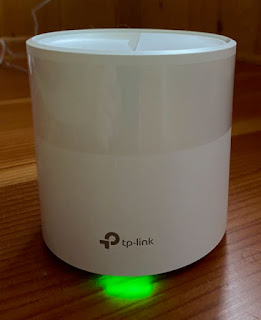I have a love/hate relationship with the TP-Link DECO X20.
I have a few of these set up in other peoples' homes. There are the things that I love about the X20, but they have serious limitations that I strongly dislike. I would recommend them to some people, but I would never buy one for my own home. Here are the details why.
Overview
The Deco X20 is a cute-looking WiFi6 (802.11ax) mesh router system.
- You can buy them in one, two, or three node packs. You can add more nodes later if you wish. One of my setups is a three node system, and one is a two node system. It might be wisest to buy the three pack and sell off any nodes you don't need.
- Each node is a dual radio device, with optional Ethernet back-haul.
- Each node has two Ethernet ports that can be used for wan uplink, lan, or client device
- They look like pretty little cylinders with an external power brick.
The Good
- These are stupidly easy to set up. There is very little configuration that needs to happen. They are pretty much in line with the Apple philosophy in terms of making home networking super-easy.
- They seem to be reliable. I have not noticed any of the devices rebooting on its own, or any other problems.
- They seem to be plenty fast. They don't have any issue meeting the speeds of my ISP (basically, a Gigabit in the best case). Sure, it can be slower at the periphery, but that's just how radio works.
- They automatically (and optionally) support Ethernet for the back-haul.
The OK
- They are good looking cylinders, so users will be tricked into leaving them out in the open, which is always going to be better than leaving them in a cabinet or behind the sofa. But wall mounting requires the purchase of custom 3rd party brackets, and ceiling mounting is a "never".
- The smartphone app is pretty decent. Hopefully they don't kill it prematurely like so many vendors do. No one buys devices to just throw them into the e-waste bin after a few years.
- Like any WiFi device, placement is important. It's a good idea to minimize node count.
- They are designed to be used indoors only. They are not compatible with very hot or very cold temperatures, so they may not be suitable for placement in a garage or the porch or outdoor spaces that do not have climate control.
The Annoying
- Limited configuration options. People who disliked Apple's Airport products due to their lack of obvious configuration options will hate these far more. Even the most basic settings like channel selection and channel width are not available. In relative terms, the Airport had a ton more options.
- The device's WiFi channel selection is stupid. Sure, these are 802.11ax, but why are you choosing a 40 GHz channel in the middle of the 2.4GHz spectrum in a noisy neighborhood? It is as if TP-Link is going out of their way to noise up the spectrum, and I know of no recourse.
- Firmware updates? These are pretty new devices. I can't believe they haven't seem a firmware update in over 18 months. Bug fixes? Security fixes? I can't believe that their software is so perfect.
- No DFS, of course, as although these seem premium, in reality they are low-end consumer devices (despite the price tag suggesting otherwise).
Conclusion
I wouldn't buy the X20 for my home, but I do think they work well for people who need a very simple multi-node system within a very large residential home in outer suburbia. I'm concerned about the manufacturer's control over the device, and I hate the inability to tweak the channel settings.
